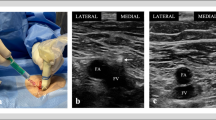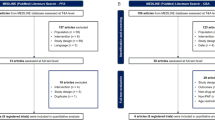Abstract
Purpose
Atrial fibrillation (AF) ablation is a common procedure to reduce cardiovascular morbidity but is limited by recurrence. The objective of this study was to determine if post-ablation acute surface P wave morphology and other electrocardiographic parameters correlate with AF recurrence.
Methods
The Avoiding Bladder Catheters During AF ablation (ABCD-AF) trial was a randomized, prospective trial in 160 subjects undergoing AF ablation. The present study examined correlation between AF recurrence in follow-up and acute post-ablation electrocardiographic P wave parameters.
Results
Median follow-up was 255 (188, 306) days. The ABCD-AF cohort had a mean age of 62.7 ± 12.8 with 32.1% being females. Rate of recurrent AF was 35.8%, with a median time to AF of 135 (109, 182) days. There was no baseline demographic associated with AF recurrence. There was more AF recurrence in those with longer follow-up (p = 0.001). Lead 2 PR interval, lead 2 P wave duration/PR (Pdur/PR), lead V1 PR interval, and lead V1 Pdur/PR were all significantly associated with recurrent AF (p = 0.03, 0.02, 0.01, 0.01). Longer PR and shorter Pdur/PR predicted AF recurrence. In a multivariable model, lead V1 Pdur/PR provided the best predictor of AF recurrence, with an odds ratio of 0.018 (p = 0.016) per standard deviation change.
Conclusions
Shorter P wave duration combined with longer AV node delay, as measured by proportion of the PR that the P wave occupies, was the best predictor of AF recurrence post-ablation.


Similar content being viewed by others
Data availability
Relevant data is disclosed within the body of the manuscript and full data will be made available upon reasonable request.
Code availability
There is no code availability to disclose.
Abbreviations
- ABCD-AF:
-
Avoiding Bladder Catheters During AF ablation
- AF:
-
Atrial fibrillation
- CA:
-
Catheter ablation
- ECG:
-
Electrocardiogram
References
Guo Q, Du X, Ma CS. Atrial fibrillation and frailty. J Geriatr Cardiol. 2020;17:105–9.
Hagens V, Ranchor A, Sonderen E, et al. Effect of rate or rhythm control on quality of life in persistent atrial fibrillation. J Am Coll Cardiol. 2004;43:241–7.
January CT, Wann LS, Alpert JS, et al. 2014 AHA/ACC/HRS guideline for the management of patients with atrial fibrillation. JACC. 2014;64:e1-76.
Prabhu S, Taylor AJ, Costello BT, et al. Catheter ablation versus medical rate control in atrial fibrillation and systolic dysfunction: the CAMERA-MRI study. J An Coll Cardiol. 2017;70:1949–61.
Marrouche NF, Brachmann J, Andresen D, et al. Catheter ablation for atrial fibrillation with heart failure. N Engl J Med. 2018;378:417–27.
Verma A, Jiang CY, Betts T, et al. Approaches to catheter ablation for persistent atrial fibrillation. N Engl J Med. 2015;372:1812–22.
Gilge J, Ahmed A, Clark B, et al. Left atrial hypertension and the risk of early incident heart failure after atrial fibrillation ablation. J Cardiovasc Electrophysiol. 2021;32:325–32.
Dilaveris PE, Gialafos EJ, Chrissos D, et al. Detection of hypertension patients at risk for paroxysmal atrial fibrillation during sinus rhythm by computer-assisted P wave analysis. J Hypertens. 1997;17:1463–70.
Yazici M, Ozdemir K, Altunkeser BB, Kayrak M, Duzenli MA, Vatankulu MA, Soylu A, Ulgen MS. The effect of diabetes mellitus on the P-wave dispersion. Circ J. 2007;71:880–3.
Celik T, Iyisoy A, Kursaklioglu H, Kilic S, Kose S, Amasyali B, Isik E. Effects of primary percutaneous coronary intervention on P wave dispersion. Ann Noninvasive Electrocardiol. 2005;10:342–7.
Park J, Kim T, Lee JS, et al. Prolonged PR interval predicts clinical recurrence of atrial fibrillation after catheter ablation. J Am Heart Assoc. 2014;3:e001277.
Salah A, Zhou S, Liu Q, et al. P wave indices to predict atrial fibrillation recurrences post pulmonary vein isolation. Arq Bras Cardiol. 2013;101:519–27.
Ahmed AS, Clark BA, Joshi SA, et al. Avoiding bladder catheters during atrial fibrillation ablation. J Am Coll Cardiol EP. 2019;6:185–90.
Jais P, Cauchemez B, Macle L, et al. Catheter ablation versus antiarrhythmic drugs for atrial fibrillation: the A4 study. Circulation. 2008;118:2498–505.
Wilber D, Pappone C, Neuzil P, et al. Comparison of antiarrhythmic drug therapy and radiofrequency catheter ablation in patients with paroxysmal atrial fibrillation. JAMA. 2010;303:333–40.
Verma A, Champagne J, Sapp J, et al. Discerning the incidence of symptomatic and asymptomatic episodes of atrial fibrillation before and after catheter ablation (DISCERN AF): a prospective, multicenter study. JAMA Intern Med. 2013;173:149–56.
Winkle RA, Mead RH, Engel G, Patrawala RA. Long-term results of atrial fibrillation ablation: the importance of all initial ablation failures undergoing a repeat ablation. Am Heart J. 2011;162(1):193–200.
Pranata R, Yonas E, Vania R. Prolonged P-wave duration in sinus rhythm pre-ablation is associated with atrial fibrillation recurrence after pulmonary vein isolation-a systematic review and meta-analysis. Ann Noninvasive Electrocardiol. 2019;5:e12653.
Frustaci A, Chimenti C, Bellocci F, Morgante E, Russo MA, Maseri A. Histological substrate of atrial biopsies in patients with lone atrial fibrillation. Circulation. 1997;96:1180–4.
Kostin S, Klein G, Szalay Z, Hein S, Bauer E, Schaper J. Structural correlate of atrial fibrillation in human patients. Cardiovasc Res. 2002;54:361–79.
Wilhelm M, Kirste W, Kuly S, Amann K, Neuhuber W, Weyand M, et al. Atrial distribution of connexin 40 and 43 in patients with intermittent, persistent and postoperative atrial fibrillation. Heart Lung Circ. 2006;15:30–7.
Onorati F, Curcio A, Santarpino G, Torella D, Mastroroberto P, Tucci L, Indolfi C, Renzulli A. Routine ganglionic plexi ablation during Maze procedure improves hospital and early follow-up results of mitral surgery. J Thorac Cardiovasc Surg. 2008;136(2):408–18.
Aryana A, Baker JH, Espinosa Ginic MA, Pujara DK, Bowers MR, O’Neill PG, Ellenbogen KA, Di Biase L, d’Avila A, Natale A. Posterior wall isolation using the cryoballoon in conjunction with pulmonary vein ablation is superior to pulmonary vein isolation alone in patients with persistent atrial fibrillation: a multicenter experience. Heart Rhythm. 2018;15(8):1121–9.
Romero J, Gabr M, Patel K, Briceno D, Diaz JC, Alviz I, Trivedi C, Mohanty S, Polanco D, Della Rocca DG, Lakkireddy D, Natale A, Di Biase L. Efficacy and safety of left atrial appendage electrical isolation during catheter ablation of atrial fibrillation: an updated meta-analysis. Europace. 2020. https://doi.org/10.1093/europace/euaa266.
Valderrábano M, Peterson LE, Swarup V, Schurmann PA, Makkar A, Doshi RN, DeLurgio D, Athill CA, Ellenbogen KA, Natale A, Koneru J, Dave AS, Giorgberidze I, Afshar H, Guthrie ML, Bunge R, Morillo CA, Kleiman NS. Effect of catheter ablation with vein of Marshall ethanol infusion vs catheter ablation alone on persistent atrial fibrillation: the VENUS randomized clinical Trial. JAMA. 2020;324(16):1620–8.
Calkins H, Gache L, Frame D, Boo LM, Ghaly N, Schilling R, Deering T, Duytschaever M, Packer DL. Predictive value of atrial fibrillation during the post radiofrequency ablation blanking period. Heart Rhythm. 2021;18:366–73.
Author information
Authors and Affiliations
Contributions
All authors of this manuscript have contributed a sufficient amount to be included as an author. All authors have reviewed the data and manuscript and approve this document.
Corresponding author
Ethics declarations
Ethics approval
This research project did receive IRB and ethics approval from our local institution.
Consent to participate
Consent was not required given the retrospective nature of the project.
Consent for publication
Consent was not required given the retrospective nature of the project.
Conflict of interest
PJP has received honoraria from Biosense Webster, Inc. None of the other authors have any conflicts of interest to disclose.
Additional information
Publisher's note
Springer Nature remains neutral with regard to jurisdictional claims in published maps and institutional affiliations.
Supplementary Information
ESM 1
(DOCX 30.0 KB)
Rights and permissions
About this article
Cite this article
Supanekar, N., Gilge, J.L., Ahmed, A. et al. Post-ablation P wave characteristics correlate with recurrent atrial fibrillation in the ABCD-AF cohort. J Interv Card Electrophysiol 64, 437–442 (2022). https://doi.org/10.1007/s10840-021-01049-0
Received:
Accepted:
Published:
Issue Date:
DOI: https://doi.org/10.1007/s10840-021-01049-0




